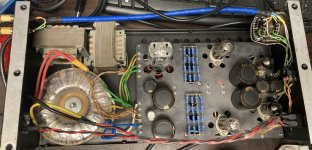Hello,
What do you think of the on/off dc transient caused by output capacitor charge/discharge in OTL amps? The following screenshots are made on a 300 Ohm termination resistorduring on/off. With the headphones connected it should be much smaller since the DC resistance of a 300 Ohm impedance headphone is much smaller, but still, the same charge goes in/out during on/off.
Don't you think it will damage the headphone sometime?
The cap I use is 470 uF.
Thanks,
JG


What do you think of the on/off dc transient caused by output capacitor charge/discharge in OTL amps? The following screenshots are made on a 300 Ohm termination resistorduring on/off. With the headphones connected it should be much smaller since the DC resistance of a 300 Ohm impedance headphone is much smaller, but still, the same charge goes in/out during on/off.
Don't you think it will damage the headphone sometime?
The cap I use is 470 uF.
Thanks,
JG

Maybe you could ameliorate the issue by using a smaller value drain resistor to ground, right after the capacitors.
It could help discharge those spikes better.
If you use a 100KΩ resistor there for example, you could lower the value quite a bit.
For example you could go as low as 3300Ω, without lowering the total impedance by a great amount (275Ω total, with 300Ω headphones connected).
It could help discharge those spikes better.
If you use a 100KΩ resistor there for example, you could lower the value quite a bit.
For example you could go as low as 3300Ω, without lowering the total impedance by a great amount (275Ω total, with 300Ω headphones connected).
Thank you for your reply.
I made measurements with a 300 Ohm resistor, to simulate the 300 Ohm can in a HD800 headphone. The DC resistance is about 300 Ohm. If I put a parallel 100k or 3k3 resistor, that would not change much.
If I make it 275 Ohm instead of 300 Ohm, that will reduce a little bit, like from 60V to 50V peak, but in general the question is the same.
I made measurements with a 300 Ohm resistor, to simulate the 300 Ohm can in a HD800 headphone. The DC resistance is about 300 Ohm. If I put a parallel 100k or 3k3 resistor, that would not change much.
If I make it 275 Ohm instead of 300 Ohm, that will reduce a little bit, like from 60V to 50V peak, but in general the question is the same.
I'm wondering if someone use some kind of voltage limiter, like two zener facing each other? Zeners I have tried before, I think 2 10V zener and it did colored the sound.
Do you have any other suggestion?
Thanks,
JG
Do you have any other suggestion?
Thanks,
JG
Short the output with a relay to ground for 10 seconds upon turn on/off.
I consider to use speaker protection circuit, but wiring the relay to shorting. On the other hand, I'm wondering if someone tried something more sophisticated, continuous protection, but not effecting sound like my 2 zener.
MOVs would work and also for positive and negative.
A 10K resistor would help but also the speed if startup plays a role. The faster the start, the larger the AC slew rate so the mechanism on the other side then has to cope with that.
MOVs are used for mains transients so a low voltage MOV could provide a good transient overvoltage protection.
Most tube amps use a follower design, so the voltage difference across the cap is minimal, even at power on.
Is the design a follower?
A 10K resistor would help but also the speed if startup plays a role. The faster the start, the larger the AC slew rate so the mechanism on the other side then has to cope with that.
MOVs are used for mains transients so a low voltage MOV could provide a good transient overvoltage protection.
Most tube amps use a follower design, so the voltage difference across the cap is minimal, even at power on.
Is the design a follower?
- Home
- Amplifiers
- Headphone Systems
- output capacitor in OTL headphone amp